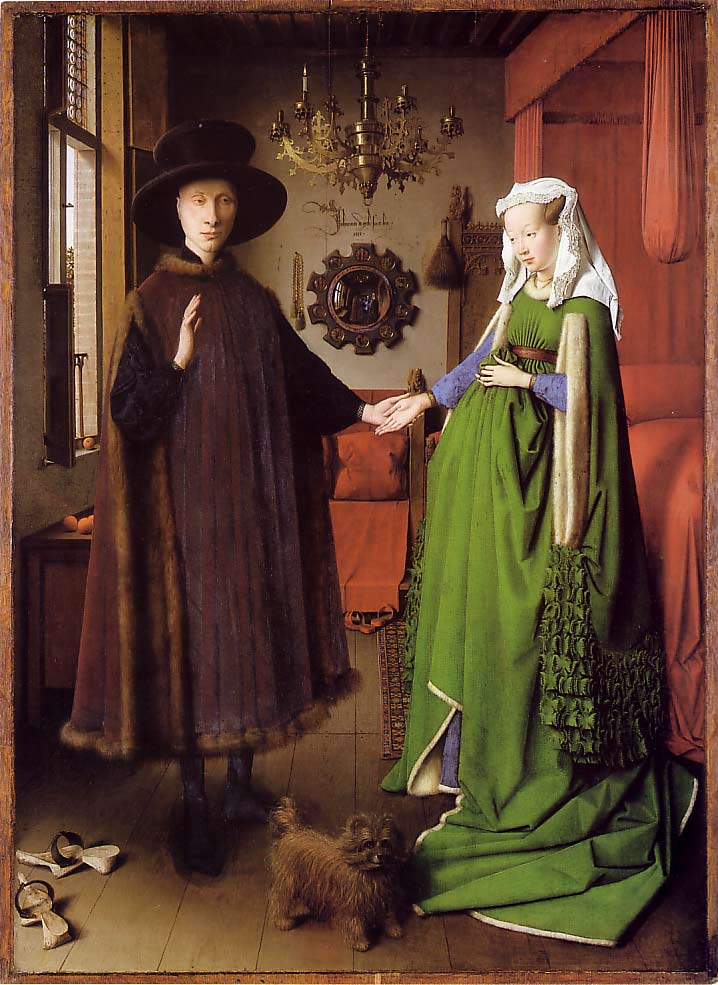
“If we want to understand the way in which northern art developed we must appreciate [the] infinite care and patience of Jan van Eyck. Van Eyck… achieved the illusion of nature by adding detail upon detail till his whole picture became like a mirror of the visible world…
“Probably [Van Eyck] was asked to record [the betrothal of Arnolfini] as a witness, just as a notary might be asked to declare that he has been present at a similar solemn act… We do not know whether it was the Italian merchant or the northern artist who conceived the idea of making this use of the new kind of painting, which may be compared to the legal use of a photograph, properly endorsed by a witness. Whoever it was that originated this idea, he had certainly been quick to understand the tremendous possibilities which lay in Van Eyck’s new way of painting. For the first time in history the artist had become the perfect eye-witness.”
Ernst H. Gombrich, “Chapter 12: The Conquest of Reality,” The Story of Art, 15th edition

So glad you posted this! It is one of my absolute favorite paintings! I am such a fan of Northern symbolism. While I revel in Italian art’s glory and their famous idealized figures, I am so captivated by the patience and care to detail and meaning the Northern artists used!
I cannot begin to say how much I appreciate Van Eck’s enormous care to detail! My Art History professor told me that he counted at least 43 symbols in the painting! 43!!! There are so many meanings behind little details in this painting, but my favorite is the single lit candle on the chandelier, representing the light of God. Also, I am fascinated with the way Van Eck inscribed “Van Eck Was Here” on the back wall! (excited squeal!)
I used to think that the betrothed woman is pregnant, and thought it a strange, scandalous painting, but my professor gave me this story as an explanation:
Arnolfini’s bride was removed her shoes in the far end of the room and knelt to pray on the pillows in front of the mirror. Since her dress is so long, she had to lift it up before her to raise herself to greet her visitors (accidentally giving the impression of being pregnant). The moment is frozen in the time when she is still holding up her gown as she steps to the side of her bridegroom. van Eck might have also had her standing is such a way to symbolize fertility, but I doubt that – it’s just too strange.
What any thoughts on that?
Ouch. That was a long comment. Sorry! I just love Van Eck!
This is one of my favorite paintings to study, as well.
I have always read that the green color and suggestive contour were symbolic of fecundity. Here van Eyck paints a symbol that, like the others (the candle, as you said), can be explained realistically in context. (The candle symbolizes God, but as a mere object we can still understand its presence. The rounded belly symbolizes fertility, but we can still explain why she looks like that even though she’s not currently pregnant.) Marriage was primarily valued for the raising of godly children, and it would not have been strange for the couple to be regaled with symbolic, direct, or coyly indirect wishes for lots of them.
I question your teacher’s interpretation of the painting as a “candid shot.” The realism of the time was found in the abundance of details—not in the “frozen moment” quality we see later in Impressionism. Also, this painting was a record of the betrothal. If you were going to choose a single photograph from your wedding, which would you choose? The one of you getting up to greet guests and looking fat?
You are absolutely right about the earlier admiration for pregnancy as a means of producing Godly children. I think that is the way Arnolfini’s bride should be interpreted, but we, in our modern thinking, cannot fully grasp the reason she would enjoy being portrayed as pregnant.
I would definitely not approve of my looking pregnant in ANY photo – especially my betrothal picture! I don’t believe this is a capture moment as in the Impressionist period, however, I do believe it is less regale in comparison with most Northern portraits. This one is more fluent, more intimate, as if you are standing in the room with them. It may not be camera-like realism like Rosa Bonheur, but – in my opinion – it does seem to be more of a scene rather than a portrait.
I have read many theories on this painting, and I refuse to accept any as “the reason” because I think Van Eck is meant to be full of secret meanings and colorful mysteries.